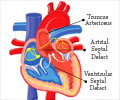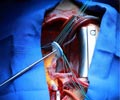Creld1 is found to be the key gene for the development of heart valves in mice. This discovery is an important step forward in the understanding of the pathogenesis of heart valve defects.

For years, there have been indications that changes in the so-called Creld1 gene (Cysteine-Rich with EGF-Like Domains 1) increase the pathogenic risk of AVSD. However, the exact molecular connection between the gene and the disease was previously unknown. A research team from the LIMES Institute and the caesar research center in Bonn has now shown, in a mouse model, that Creld1 plays a crucial role in heart development. Researchers at the University of Bonn switched off the Creld1 gene in mice: "We discovered that the precursor cells of the heart valves and the cardiac septum could no longer develop correctly," reports Dr. Elvira Mass from the LIMES Institute. This was an important indication that Creld1 is required at a very early stage for the development of the heart.
In embryonic development, the heart develops as the first organ
"In the embryonic stage, the heart develops as the very first organ. It pumps blood through the vascular system and is essential for supplying other organs of the body with oxygen and nutrients," reports the cooperation partner, Dr. Dagmar Wachten who directs the Minerva research group "Molecular Physiology" at the caesar research center and is engaged in research involving cardiac development. The research team discovered that the Creld1 gene controls the development of heart valves via the so-called calcineurin NFAT signaling pathway. The heart valve defects in mice lacking the Creld1 gene ultimately led to insufficient oxygen supply to the body, causing the mouse embryo to cease development after approximately eleven days.
Potential starting point for improving diagnostic measures
The research team anticipates that the findings can be carried over to patients. With regard to cardiac development, mice and humans are very similar and the Creld1 gene and the calcineurin/NFAT signaling pathway likewise function analogously in both species. "Our results contribute to a better understanding of the molecular basis of heart development and, in the medium-term, to improved diagnosis of unidentified heart valve diseases," explains Prof. Hoch. Interestingly, the calcineurin/NFAT signaling pathway is not only active in the heart but also in immune cells. In transplant medicine, it has to be suppressed over the long-term by drugs such as cyclosporine A so that transplanted organs are not rejected. "Within the scope of the ImmunoSensation Excellence Cluster, we are currently investigating the mechanism of action of Creld1 in immune cells," says Prof. Hoch, who is convinced that it will also be of importance in transplant medicine in the future.
Advertisement















